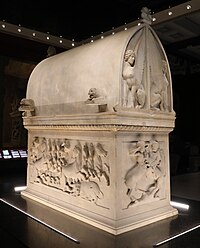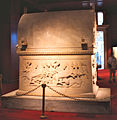| Lycian sarcophagus of Sidon | |
|---|---|
 Lycian sarcophagus in Parian marble from the Sidon necropolis. Lycian sarcophagus in Parian marble from the Sidon necropolis. | |
| Material | Parian marble |
| Created | 430-420 BC |
| Discovered | 1887 |
| Present location | Istanbul Archaeological Museums |
The Lycian sarcophagus of Sidon is a sarcophagus discovered in the Royal necropolis of Ayaa near Sidon, Lebanon. It is made of Parian marble, and resembles the shapes of ogival Lycian tombs, such as the Tomb of Payava, hence its name. It is now located in the Istanbul Archaeological Museum. It is dated to circa 430–420 BC. This sarcophagus, as well as others in the Sidon necropolis, belonged to a succession of kings who ruled in the area of Phoenicia between the mid-5th century BC to the end of the 4th century BC.
The sarcophagus was decorated in Greek sculptural style by Greek artists from Ionia, but incorporating the general shape of the ogival tombs from Lycia, such as the Tomb of Payava. This is sometimes presented as an example of Greco-Persian art, although this should be qualified more precisely as Greco-Anatolian art, since such examples are unknown in the wider Achaemenid Empire.
The sarcophagus is decorated with reliefs, the side reliefs illustrating a lion-hunt and a boar-hunt, while the reliefs at the end show fighting centaurs and sphinxes.
The Lycian sarcophagus of Sidon, is, together with the famous Alexander Sarcophagus, one of four massive carved sarcophagi, that were discovered during the excavations of the Ayaa Necropolis conducted by Osman Hamdi Bey, an Ottoman of Greek descent and Yervant Voskan, an Ottoman of Armenian descent, at the necropolis near Sidon, Lebanon in 1887.
See also
References
- Freely, John; Glyn, Anthony (2000). The Companion Guide to Istanbul and Around the Marmara. Companion Guides. p. 71. ISBN 9781900639316.
- Dinsmoor, William Bell; Anderson, William James (1973). The Architecture of Ancient Greece: An Account of Its Historic Development. Biblo & Tannen Publishers. p. 68. ISBN 9780819602831.
- Franks, Hallie M. (2013). Hunters, Heroes, Kings: The Frieze of Tomb II at Vergina. American School of Classical Studies at Athens. p. 130. ISBN 9781621390107.
- Rose, Charles Brian (2014). The Archaeology of Greek and Roman Troy. Cambridge University Press. p. 312. ISBN 9780521762076.
- ^ Freely, John; Glyn, Anthony (2000). The Companion Guide to Istanbul and Around the Marmara. Companion Guides. p. 71. ISBN 9781900639316.
- Palagia, Olga (2017). Regional Schools in Hellenistic Sculpture. Oxbow Books. p. 285. ISBN 9781785705489.
| Istanbul Archaeology Museums | |||||
|---|---|---|---|---|---|
| Buildings | |||||
| Departments and objects |
| ||||







